Airport Ramp Worker Dies after Being Struck by a Deicing Truck - Massachusetts
Massachusetts Case Report: 04-MA-043
Release Date: January 17, 2007
Summary
On December 7, 2004, a 43-year-old male airport ramp worker (the victim) was fatally injured after being struck by a deicing truck while walking across the area around an airport terminal where aircraft are loaded and unloaded (apron). The deicing truck was being driven by a co-worker across the apron from the airline’s gate area to the hangar. The victim was struck by the right side of the deicing truck’s bumper and was run over by the truck’s right side front and rear wheels. Calls were placed to emergency medical services (EMS). EMS personnel arrived at the site to attend to the victim who was pronounced dead at the airport. The Massachusetts Fatality Assessment and Control Evaluation (FACE) Program concluded that to prevent similar occurrences in the future, employers should:
- Purchase and use deicing equipment that does not obstruct the view of the vehicle operator while driving
- Designate pedestrian walkways within the airport apron for ground crew
- Prohibit employees from wearing loose hoods while working around moving vehicles and equipment on airport aprons
- Supply and ensure that employees wear appropriate personal protective equipment, such as the American National Standard Institute (ANSI) compliant high visibility safety apparel
- Ensure that their comprehensive written health and safety program includes specific training for deicing operators and workers on foot regarding areas around vehicles and equipment where operators would have obstructed views
Also, employers using deicing vehicles where operators have obstructed views while driving should:
- Require a second employee to assist the vehicle operator during driving of the vehicle
- Consider installing after market devices (e.g., camera, radar, and sonar) on vehicles and equipment to help monitor the presence of workers on foot
In addition, manufacturers of aircraft deicing equipment and vehicles should:
- Design equipment such that the operator’s view is not obstructed while driving
- Explore the possibility of incorporating new monitoring technology (e.g., radio frequency identification (RFID) tags and tag readers) on equipment to help monitor the presence of workers on foot and in blind areas
Introduction
On December 7, 2004, the Massachusetts FACE Program was alerted by local media that on the same day an airport worker was fatally injured when struck by a deicing truck. An investigation was initiated. On December 29, 2004 the Massachusetts FACE Director and an investigator traveled to the airline offices at the airport where the incident occurred and interviewed the airline’s safety coordinator. The death certificates, corporate information, and Occupational Safety and Health Administration (OSHA) information were reviewed during the course of the investigation. In addition, photographs were taken of a deicing truck that was the same make and model as the truck involved in the incident.
The employer is an airline that employs approximately 450 workers at this airport location. The victim’s job title was ramp worker, which entailed loading and unloading bags from aircraft as well as deicing aircraft. Approximately 50 other employees also held the job title ramp worker. The victim, with over 14 years of experience as a ramp worker for this airline, worked the first shift from 5:00 a.m. – 1:00 p.m. The operator of the deicing truck had held the job title of ramp supervisor for many years.
The company had a written health and safety program and provided employees with health and safety training. The initial training for ramp workers was a three week training consisting of classroom, on-the-job, and computer based sessions that included apron (the area around an airport terminal where aircraft are loaded and unloaded) safety. In addition to the initial training, the ramp workers received an annual training that addressed deicing operations as mandated by the Federal Aviation Administration (FAA). The ramp workers did not have union representation.
Investigation
On the day of the incident, the victim began work at 5:00 a.m. It was dark and the skies were overcast with rain. The temperature had been holding above freezing (38° F) with winds out of the east at 18 MPH.
His first task was to unload luggage from an aircraft that had just arrived and was parked at gate 21. Once this was completed, the victim started preparing this same plane for its next flight by loading the plane with early arriving passengers’ luggage. The victim then walked across the airport apron for a break. At approximately 6:30 a.m., after the break, the victim stepped out onto the apron and started to walk back towards gate 21 to continue loading luggage onto the aircraft. The quickest way to get to gate 21 from the location where the victim spent his break was to cut across the apron. At the time of the incident, the victim was cutting across the apron and was wearing a hooded sweatshirt, with the hood up, underneath his company issued coat and an orange reflective vest over his coat. He also wore steel toe shoes, a hat, gloves, and hearing protection (ear muffs). The victim’s company issued vest was not in compliance with the then current American National Standards Institute/International Safety Equipment Association ANSI/ISEA 107-1999 standard – High Visibility Safety Apparel and Headwear. Since this incident, an updated version of this standard has been released (ANSI/ISEA 107-2004).
A deicing truck had been parked at gate 28 due to forecasted weather, which predicted precipitation and cold temperatures which could create icy conditions. Deicing tasks at this airport began around November and would continue through April. Aircraft deicing is required by the FAA to ensure safe operation of the aircraft and therefore passenger safety. The deicing task involves the removal of frost, snow, or ice from aircraft surfaces.1 Prior to the incident, it was determined that departing planes did not need deicing and it was decided to move the deicing truck back to the airline hanger, located approximately one mile away.
The deicing truck involved in the incident was manufactured in 2002 (Figure 1). The truck is equipped with an enclosed bucket attached to a hydraulic articulated boom. The bucket’s measurements are 42 inches wide and 44 inches deep. The truck’s windshield measures 62 inches wide. When the deicing truck is being driven, and is not in the deicing operation mode, the bucket is located in front of the truck’s windshield. This is the “holstered” position (Figure 2). This design obstructs the truck operator’s view when looking through the windshield (Figure 3). When the truck is in deicing operation mode, the bucket is “unholstered”. The truck is equipped with a governor which limits its maximum driving speed. The truck’s maximum speed while the bucket is holstered, as in this incident, is 25 miles per hour (MPH) and the truck’s maximum speed when the bucket is unholstered is 4 MPH.
In addition to typical motor vehicle lighting, such as headlights, taillights, and side marker lights, the deicing truck was equipped with one yellow beacon light located at the rear of the truck, which was operating at the time of the incident. The airline owns approximately 10 deicing trucks and had multiple deicing trucks parked at the airline’s gates in preparation for deicing operations on the morning of the incident. That morning, the truck’s tank was full of deicing fluid, bringing the weight of the truck to approximately 22 tons.
The morning of the incident, aircraft had been parked at all of the airline’s terminal gates. None of these aircraft engines were running. During the investigation, it was reported that the apron lighting was poor and it would have been dark at the incident location. The victim was walking in a northerly direction across the apron while a co-worker was driving the deicing truck in an easterly direction, also across the apron. The co-worker had driven the deicing truck approximately 400 yards away from gate 28 before striking the victim. The victim was struck by the right side of the deicing truck’s bumper and was run over by the truck’s right side front and rear wheels. It appears that the co-worker driving the deicing truck never saw the victim because his view through the truck’s windshield was obstructed by the deicing truck’s bucket in the holstered position. Also, it appears that the victim did not hear or see the deicing truck because he was wearing hearing protection and had the sweatshirt’s hood up, which might have blocked his peripheral vision.
The co-worker driving the truck heard a thump that came from the right side of the truck and stopped the deicing truck. Once the truck was stopped, the co-worked exited the truck and saw the victim. The co-worker then immediately notified management of the incident who called for emergency medical services (EMS). EMS arrived within minutes and the victim was pronounced dead at the airport.
A fuel truck owned and operated by a different company was parked nearby and the operator of the fuel truck had a clear view of the incident. The fuel truck operator noticed that the victim and the deicing truck were on a path for collision and he blew his truck’s horn. It appears that neither the victim nor the deicing truck operator heard the warning.
The vehicles that are kept on the airport grounds, including deicing trucks, are not permitted to be operated on public roadways. These vehicles are annually inspected by the state authority that manages the airport where the incident occurred. The state authority requires that deicing truck operators have a valid driver’s license for regular passenger vehicles; a Commercial Driver’s License is not required.
Since the incident, the airline has informed the Massachusetts FACE Program of three changes that have been made. These changes are:
- Two employees are required inside a deicing truck’s cab when the truck is being moved with the bucket in the holstered position (non-deicing mode operation)
- Employees on foot are prohibited from walking across aprons and should get a ride or walk through the terminal to access the other side of an apron
- Employees are required to wear company supplied ANSI Class 2 safety vests or jackets while on the apron
Cause of Death
The medical examiner listed the cause of death as massive traumatic injuries.
Recommendations/Discussion
Recommendation #1: Employers should purchase and use deicing equipment that does not obstruct the view of the vehicle operator while driving.
Discussion: When deciding what equipment to purchase, employers should research and compare available equipment and take into consideration the health and safety of the employees that will operate and work near the equipment. Deicing equipment designed not to obstruct the view of the operator is available (Figure 4) and should be considered as the top choice when purchasing equipment for deicing operations.
Recommendation #2: Employers should designate pedestrian walkways within the airport apron for ground crew.
Discussion: To protect workers on foot who have tasks to complete within the airport apron area, employers should designate walkways along the perimeter of the apron area for these workers. The walkways should be outlined and motor vehicles and planes should be prohibited from entering. In addition, company regulations should be developed, implemented, and enforced that prohibit workers on foot from exiting the designated walkways and crossing over onto the apron.
Recommendation #3: Employers should prohibit employees from wearing loose hoods while working around moving vehicles and equipment on airport aprons.
Discussion: The victim was walking across the airport’s apron while wearing required hearing protection, which limited his hearing of the surrounding noises and wearing his hood up, which might have blocked his peripheral vision. Both of these factors may have contributed to the incident, along with the deicing truck operator’s obstructed view while driving the vehicle. Employers should prohibit workers from using hoods while out on airport aprons and when performing tasks around moving vehicles and equipment. To keep warm in the winter months, employers should supply and require the use of hats or other tight fitting head and neck gear that will not restrict the wearers’ vision.
Recommendation #4: Employers should supply and ensure that employees wear appropriate personal protective equipment, such as the American National Standard Institute (ANSI) compliant high visibility safety apparel.2
Discussion: Personal protective equipment for workers on foot required to work within the apron area of an airport should include ANSI compliant high visibility safety apparel. The ANSI standard for High-Visibility Safety Apparel (ANSI/ISEA 107-2004) is published by the International Safety Equipment Association (ISEA), and recommends specific types of reflective equipment while working near moving vehicles. In this case, the workers should have been required to wear a Class 2 garment that was supplied by the employer.
- Class 2 garments are intended for use where greater visibility is necessary during inclement weather conditions and when activities occur near roadways where traffic speeds exceed 25 mph
The standard also states that a competent person designated by the employer should be responsible for selecting the appropriate class of garment for workers. A competent person, as defined by OSHA, is a person who, through training or knowledge, is capable of identifying existing and predictable hazards in the surroundings or working conditions that are unsanitary, hazardous, or dangerous to employees, and who has authorization to take prompt corrective measures to eliminate them.
Recommendation #5: Employers should ensure that their comprehensive written health and safety program includes specific training for deicing operators and workers on foot regarding areas around vehicles and equipment where operators would have obstructed views.3,4,5,6
Discussion: OSHA regulations require employers to provide training to workers about recognizing and avoiding unsafe conditions that may be present in their work environments and to provide training on the regulations applicable to their work. Training should be a vital part of airports’ written comprehensive health and safety program and should address, at a minimum, all known and anticipated hazards. Employers should evaluate all tasks performed by employees for potential hazards and incorporate these identified hazards and their controls into training on hazard recognition and avoiding unsafe conditions.
All workers whose tasks will bring them to the apron should be made aware of the blind areas that exist around vehicles and equipment and they should receive specific training in the identification of these blind areas. A blind area (or blind spot) is the area around a vehicle or equipment that is not visible to the operator, either by direct line-of-sight or indirectly by the use of internal and external mirrors. Training on vehicle and equipment blind areas is important for both equipment operators and workers on foot in proximity to vehicles and equipment. As part of a research project evaluating different strategies to prevent worker injuries in construction work zones, the National Institute for Occupational Safety and Health (NIOSH) contracted with Caterpillar to provide blind area diagrams for 38 different vehicles or machines used in the construction industry. Similar diagrams for airport apron vehicles may be useful in worker training.
The content of the training programs and the names and dates of employees completing the training should be documented and retained by the employer. Employers should ensure that the trainer who provides training is qualified through education and/or experience to conduct training. A summary of OSHA’s draft proposed safety and health program rule, which discusses employee training, has been included at the end of this report.
Recommendation #6: Employers using deicing vehicles where operators have obstructed views while driving should require a second employee to assist the vehicle operator during driving of the vehicle.
Discussion: During the site visit it was reported by the airline that since the incident, the company is requiring that a second worker ride inside the deicing vehicle’s cab with the driver when the bucket is in the holstered position (non-deicing operation) and being driven. The second worker’s task is to assist the driver in seeing obstacles while driving the deicing vehicle, such as workers on foot, equipment, vehicles, and aircraft.
Recommendation #7: Employers using deicing vehicles where operators have obstructed views while driving should consider installing after market devices (e.g., camera, radar, and sonar) on vehicles and equipment to help monitor the presence of workers on foot.7,8
Discussion: Cameras and sensors based on radar, sonar, and infrared technology are available to help monitor vehicle and equipment blind spots. Although improvements may be needed to make this technology more durable in rough physical environments, this equipment shows promise as a tool for worker safety. A camera mounted on the vehicle or equipment at the location of the obstructed area would provide the operator a view of this area on a video monitor in the cab. Sensor systems provide an alarm in the cab when a person or other obstacle is detected at the rear of the equipment. A combination of a camera and a sensor system may offer the best protection.
Recommendation #8: Manufacturers of aircraft deicing equipment and vehicles should design equipment such that the operator’s view is not obstructed while driving.
Discussion: In this case, the operator’s view when looking through the vehicle’s windshield on which the equipment was mounted was obstructed when the bucket was in the holstered position. The obstructed windshield prohibits the vehicle from being operated legally on Massachusetts public roadways. Manufacturers of airplane deicing equipment should develop designs that conform to visibility requirements for public roadway use.
Recommendation #9: Manufacturers of aircraft deicing equipment and vehicles should explore the possibility of incorporating new monitoring technology (e.g., radio frequency identification (RFID) tags and tag readers) on equipment to help monitor the presence of workers on foot and in blind areas.7,8,9
Discussion: Limited visibility when operating vehicles and equipment has been attributed in part to workers on foot being struck by these vehicles and equipment on airport aprons. In this incident, the driver stated he did not see the victim who was struck by the front right side of the deicing truck. New technologies, such as sensor based systems, rear-view cameras, and radio frequency identification (RFID) tags and tag readers are becoming available for construction equipment, though testing and demonstration at construction projects are still needed. As new or existing monitoring technologies are proven to be effective on work sites, equipment manufacturers should offer these systems on new equipment.
References
- Environmental Protection Agency [2000]. Preliminary Data Summary. Airport Deicing Operations (Revised).
- ANSI/ISEA [2004]. American National Standard for high-visibility safety apparel. New York, NY: American National Standards Institute, ANSI/ISEA 107 -2004.
- RWZSHCA [2005]. Internal traffic control plans. Washington, DC: Laborers’ Health and Safety Fund of North America under the Roadway Work Zone Safety and Health Coalition Alliance, CDC Contract 212-2003-M-02677.
- Caterpillar [2003]. Final Report: Construction Vehicle and Equipment Blind Area Diagrams. Peoria, IL: Caterpillar Inc. CDC, NIOSH contract no. 200-2002-00563 for Highway Work Zone Project.
- Caterpillar [2004]. Final Report: Construction Vehicle and Equipment Blind Area Diagrams. Peoria, IL: Caterpillar Inc. CDC, NIOSH contract no. 200-2002-00563 for Highway Work Zone Project.
- Airport Operations Safety Panel [2004]. A Report on the Safety of Airport Operations. Reducing Accidents and Improving Safety on the Ramp.
- Ruff, T. Evaluation of Systems to Monitor Blind Areas Behind Trucks Used in Road Construction and Maintenance – Phase 1. Cincinnati, OH: U.S. Department of Health and Human Services, Centers for Disease Control and Prevention, National Institute for Occupational Safety and Health. NIOSH Report of Investigations 9660 (DHHS Publication No. 2003-113), 2003, 16 pp.
- Ruff, T. Monitoring Blind Spots – A Major Concern for Haul Trucks. Engineering and Mining Journal, V.202, N.12, December 2001, p.17-26.
- U.S. Department of Transportation [2002]. Report to Congress. Injuries and Fatalities of Workers Struck by Vehicles on Airport Aprons.
Illustrations
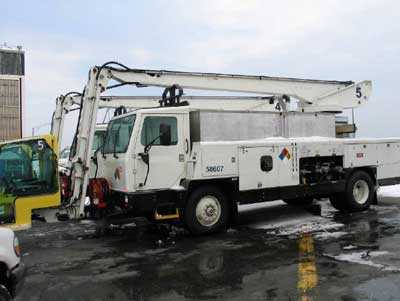 |
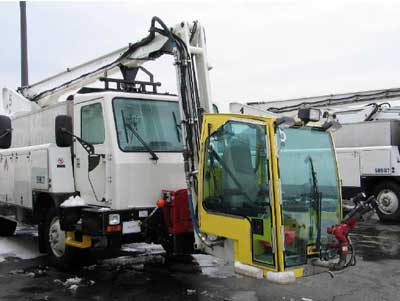 |
|
Figure 2 – Deicing bucket in the holstered position |
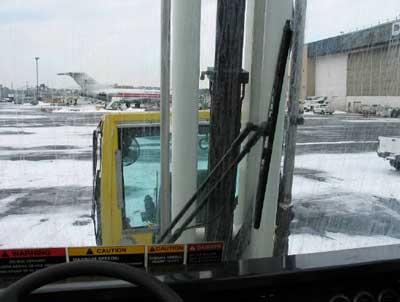 |
|
Figure 3a – View through the windshield from inside the cab of the deicing truck |
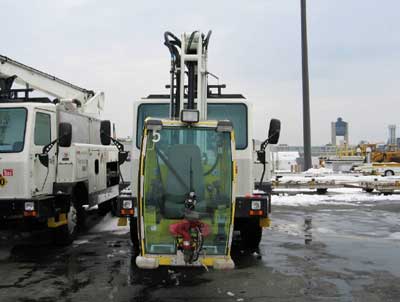 |
|
Figure 3b – View looking at the deicing bucket head-on |
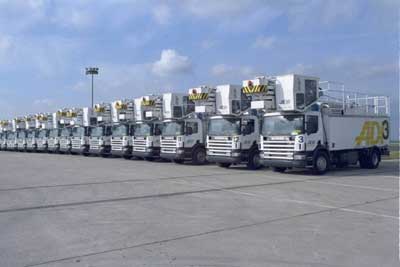 |
|
Figure 4 – Example of deicing trucks designed so the bucket is not obstructing the operator’s view while driving |
Date issued November 23, 1998.
Full text available on https://www.osha.gov/dsg/topics/safetyhealth/nshp.htmlexternal icon. (Link updated 3/21/2013)
To contact Massachusetts State FACE program personnel regarding State-based FACE reports, please use information listed on the Contact Sheet on the NIOSH FACE web site Please contact In-house FACE program personnel regarding In-house FACE reports and to gain assistance when State-FACE program personnel cannot be reached.
